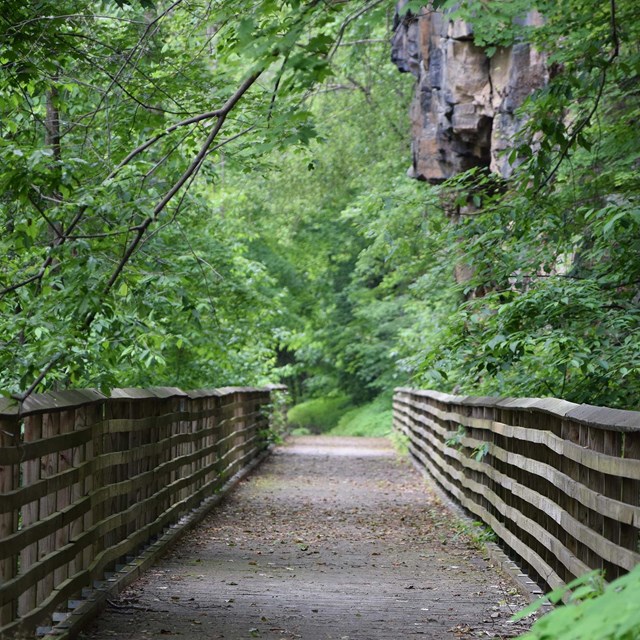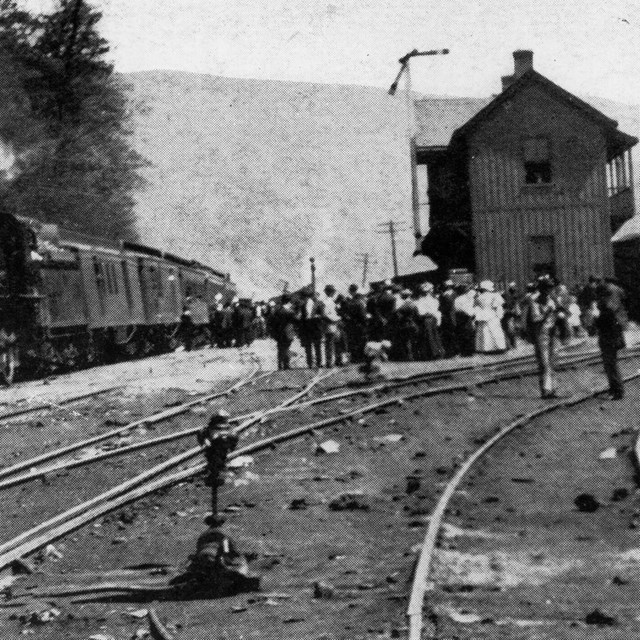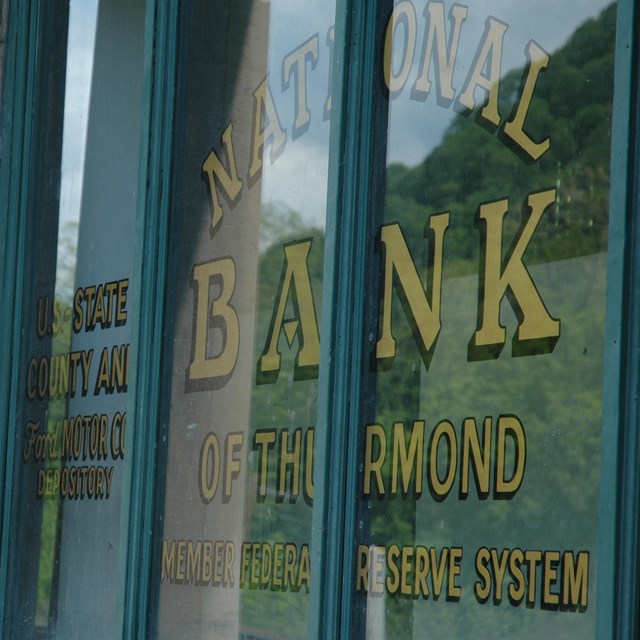
NPS / Louise McLaughlin During the first two decades of the 1900s, Thurmond was a classic boomtown. Huge amounts of coal flowed into Thurmond from the area mines. This made Thurmond the largest revenue generator on the Chesapeake & Ohio Railway. Having many coal barons among its patrons, Thurmond's banks were the richest in the state. Fifteen passenger trains a day came through town. The depot served as many as 75,000 passengers a year. With so many visitors, the hotels and boarding houses were always overflowing. The town's stores and saloons did remarkable business. But with the switch to diesel locomotives and the closing of local mines, the town began a steady decline. The many businesses closed down, and most residents moved on. Today, the town of Thurmond remains untouched by modern development. It is a link to our past, and a town with many stories to tell. Part of the mission of the National Park Service is to preserve our nation's heritage. New River Gorge National Park and Preserve invites visitors to explore Thurmond. Through it, we can experience the impact of the industrial revolution. To reach Thurmond, take U.S. Route 19 to the Glen Jean exit, north of Beckley. Follow the signs to Thurmond, seven miles down WV-25 / Thurmond Road. Travel Advisory: Thurmond Road is winding and narrow at times. Large vehicles over 25 feet in length and trailers are not recommended. 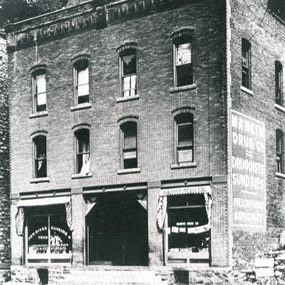
NPS Thurmond in Prosperous TimesThe year 1873 marked the completion of the Chesapeake and Ohio Railway mainline. That same year, Captain W. D. Thurmond acquired 73 acres along the railroad. Captain Thurmond saw it as a strategic position for developing a town. Thurmond was the heart of the New River Gorge. It carried shipments of coal from the surrounding coal fields. The town of Thurmond grew as the coal and timber industries expanded in the gorge. The railroad expanded the rail yard to meet the railroad’s needs. By 1910, Thurmond was the chief railroad center on the C & O Railway mainline. In 1910, the C & O operation at Thurmond was first in revenue receipts. It produced more freight tonnage than Cincinnati, Ohio, and Richmond, Virginia, combined. Freight was not the only key to this town’s success. Seventy-five thousand passengers passed through Thurmond in 1910. Some visited as tourists, delighting in all Thurmond had to offer. Others came for business or new job opportunities. At its peak, Thurmond had two hotels and two banks. The downtown area had restaurants, clothing stores, a jewelry store, and dry-good stores. The town even had a movie theater. There were many business offices for the telephone company, lawyers, and more. The town continued to thrive through the early decades of the 20th century. 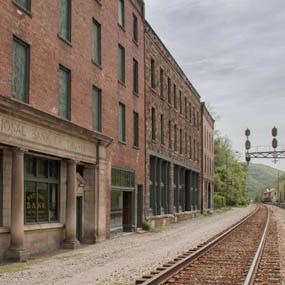
NPS / Louise McLaughlin Thurmond in DeclineWith the onset of the Great Depression, several businesses closed. This included the National Bank of Thurmond started by Captain Thurmond himself. The town’s continued to wane after two large fires wiped out several major businesses. By the mid 1930s there were other indications that Thurmond’s heyday was ending. The American public had begun its love affair with the automobile, and good roads made travel by car easy. The Chesapeake & Ohio Railway changed from steam to diesel locomotives in the 1950s. Thurmond was a steam town. Its rail yard and crews specialized steam locomotive service. Steam locomotives needed frequent stops to refill water and coal. They also needed regular maintenance work. Diesel locomotives didn't need these services. The switch to diesels left many of the rail yard structures and jobs obsolete. Once the heart of the New River Gorge, Thurmond remains its soul. Although the businesses are gone, there are still memories made here in the 21st century. The town is still incorporated and hosts an annual reunion for former residents. The mayor and city council still meet to pass ordinances and make decisions about the future of the town. 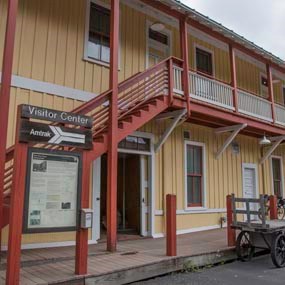
NPS / Louise McLaughlin Stabilizing Thurmond’s Past for the FutureThe National Park Service restored the Thurmond Depot as a visitor center in 1995. There are over twenty other park-owned structures in Thurmond. The National Park Service began a stabilization program in 2003. This includes repairs, removal of vegetation, drainage improvement, and exterior restoration work. To prevent damage, the park installed metal panel roofs and gutters. The addition of windows louvers helped provide proper ventilation in older buildings. Hazardous porches and additions were also removed. Historic upkeep continues at the depot to maintain its vintage 1900s appearance. The park has no current plans to renovate the interiors of the Commerical Row buildings into exhibits or museums. However, park staff performs regular upkeep and maintenance repairs. Restoration work both inside and outside helps preserve structural integrity of the buildings. Through this work, the park protects Thurmond for future generations to enjoy. In May 2023, the National Park Service Historic Preservation Training Center began work at the Thurmond Depot. HPTC staff worked to restore the depot's windows, doors, and wooden siding. Park maintenance staff also received training on the fundamentals of historic preservation. Maintenance staff will continue restoration work at the depot through Fall of 2023. Learn more about the restoration work at Thurmond Depot .Thurmond TodayThurmond, West Virginia, is listed on the National Register of Historic Places, and is in the heart of New River Gorge National Park and Preserve. The Thurmond Depot now operates as a summer visitor center. The visitor center is open daily Memorial Day weekend through Labor Day weekend. The depot is open on weekends in September and October. 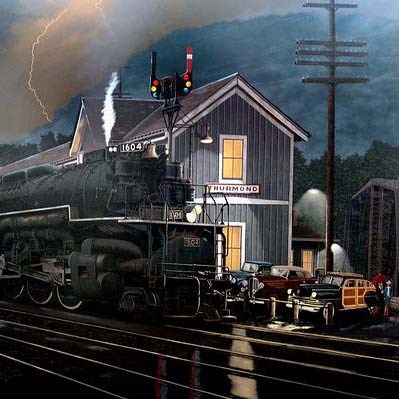
NPS "Midnight Thunder"It is a stormy evening in Thurmond, West Virginia, in the late 1940s. Next to the depot, a steam engine sits on the tracks. These tracks are the Chesapeake and Ohio Railway. Passengers await the next train departure. The painting Midnight Thunder depicts this picturesque historic scene. It's a look back at a moment in time to this once-bustling railroad town of southern West Virginia. Karl and Betty Warden commissioned this oil painting in 2003. Respected railroad scene artist Jim Jorden brought the painting to life. The Wardens both grew up in nearby Fayetteville. Their hope was to foster appreciation of the area's rich railroading history. The Wardens generously donated Midnight Thunder to the National Park Service in 2006. Explore Thurmond
Learn More
|
Last updated: December 16, 2025



